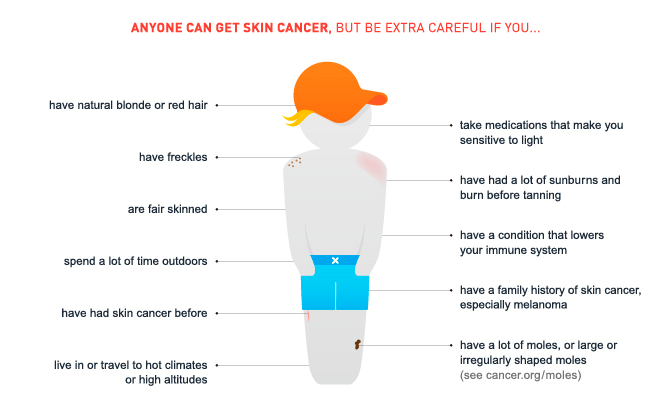Skin Cancer
Skin cancer is by far the most common type of cancer in the United States.
There are 2 main types of skin cancers: keratinocyte cancers (basal and squamous cell skin cancers) and melanomas.
- Basal and squamous cell skin cancers are by far the most common cancers of the skin. They develop from cells called keratinocytes, the most common cells in the skin. Both basal cell and squamous cell cancers are found mainly on parts of the body exposed to the sun, such as the head and neck. These cancers are strongly related to the amount of sun exposure a person has had.
- Melanomas are cancers that develop from melanocytes, the cells that make the brown pigment that gives skin its color. Melanocytes can also form benign (non-cancerous) growths called moles. Melanomas can occur anywhere on the body, but are more likely to start in certain locations. The trunk (chest and back) is the most common site in men. In women, the legs are the most common site. The neck and face are other common sites. Melanomas are not as common as basal cell and squamous cell skin cancers, but they can be far more serious because they are more likely to spread to other parts of the body, where it can be very hard to treat.
There are other types of skin cancers as well, but they are much less common.
It is important for doctors to tell these types of skin cancer apart, because they are treated differently. It is also important for you to
know what melanomas and basal and squamous cell skin cancers look like. This may help you find them at the earliest possible stage,
when they are cured most easily.
Signs and Symptoms
The most common warning sign of skin cancer is a change to your skin.
Basal cell carcinoma (BCC)
- Reddish patch of dry skin that won’t heal
- Flesh-colored (or pink, red, or brown) pearl-shaped lump
- Pimple that just won’t clear
- Sore that bleeds, heals, and then returns
- Scar that feels waxy — may be skin-colored, white, or yellow
- Group of slow-growing, shiny pink or red growths — look like sores, often scaly and bleed easily
- Flat or sunken growth — feels hard, may be white or yellow
Squamous cell carcinoma (SCC)
- Hard (scaly or crusty) reddish bump, patch, or pearl-shaped growth
- Open sore that itches and bleeds; it can heal and return
- Scaly patch on the lip; skin on the lip can get thick
Melanoma
- A mole on the skin that is growing, changing shape, or changing color
- A mole that looks scaly, oozes, or bleeds
- New dark spot on the skin that looks like a mole, but grows quickly
- Pain, itch, or bleeding in a new spot on the skin
- Streak (usually brown or black) underneath a fingernail or toenail
- Bruise on the foot that does not heal
Prevention and Early Detection
Most skin cancers are caused by too much exposure to ultraviolet (UV) rays. Most of this exposure comes from the sun, but some may come from man-made sources, such as indoor tanning beds.
Some people think about sun protection only in the summer when they are outdoors, such as at the pool. But sun exposure adds up each day - every time you are in the sun.
Here are steps you can take to protect yourself from UV rays:
- Seek shade, especially from 10am – 4pm
- Cover with clothing
- Use sunscreen
- Wear a hat
- Wear sunglasses - this protects the eyes and sensitive skin around them.
Sunscreen Tips
- Broad Spectrum Sunscreen that protects against both UVA and UVB rays (at least SPF 30)
- Water Resistant – 40 minutes of total protection
- Expiration Date – Sunscreen can expire, so check the date
- Be generous! Use about an ounce (about a palmful) should be used to cover the arms, legs, neck and face.
- Don’t forget your ears, hands, feet and underarms.
- Reapply at least every two hours. Apply more often if you’re in and out of water or sweating.
Resources
- American Academy of Dermatology
- American Cancer Society
- Centers for Disease Control and Prevention (CDC)
- National Cancer Institute at the National Institutes of Health
- The Skin Cancer Foundation
Sources: American Cancer Society, American Academy of Dermatology






















